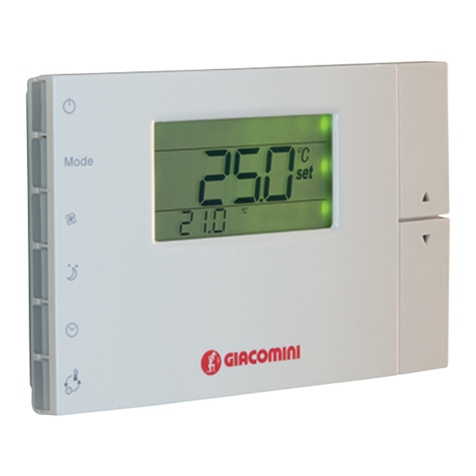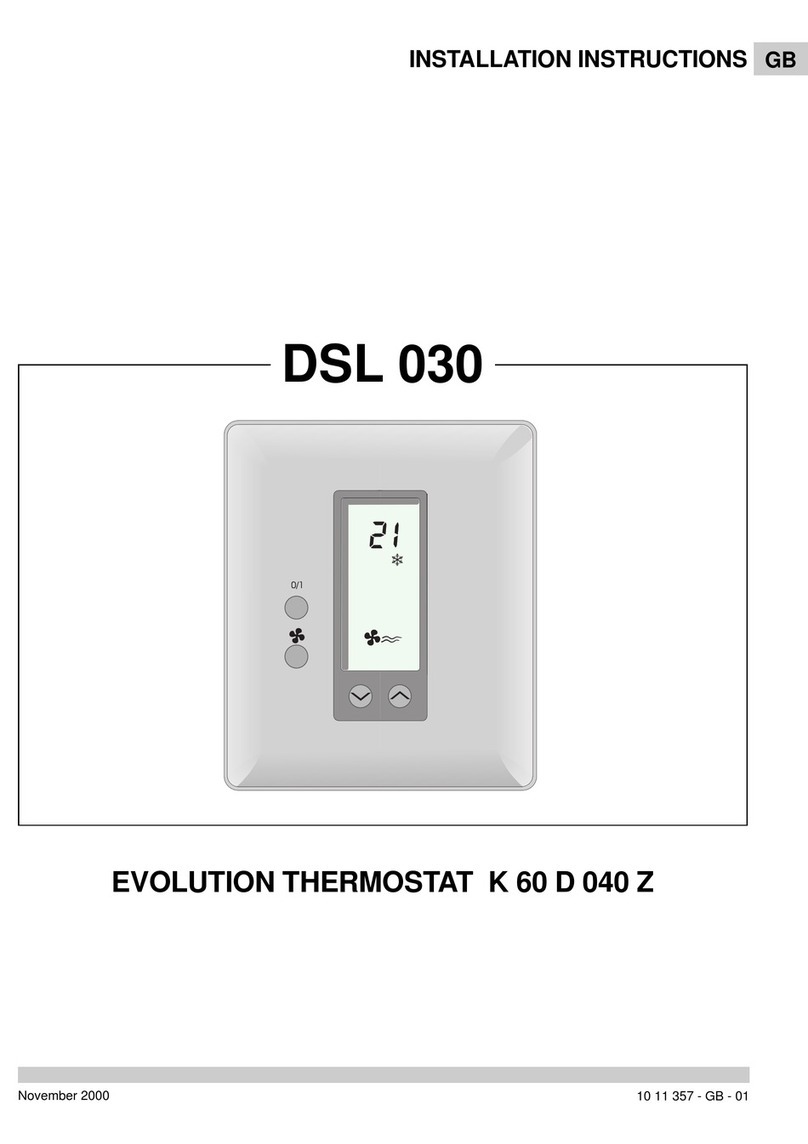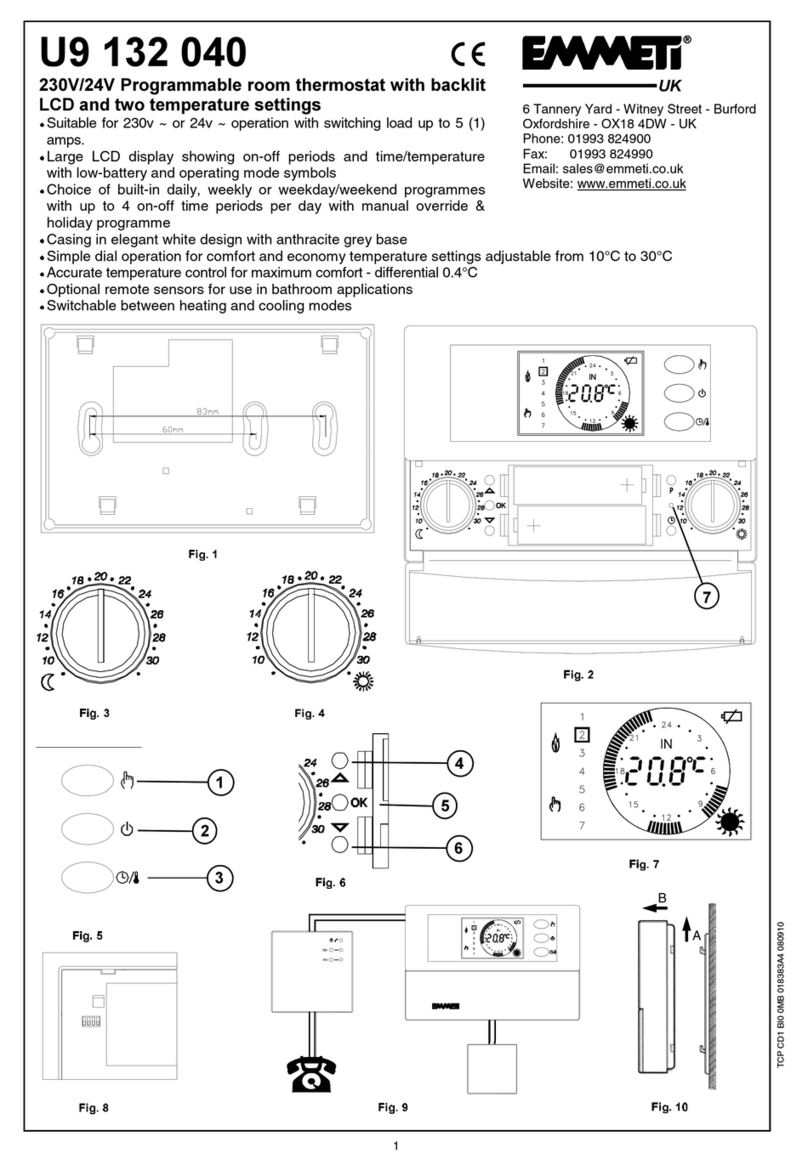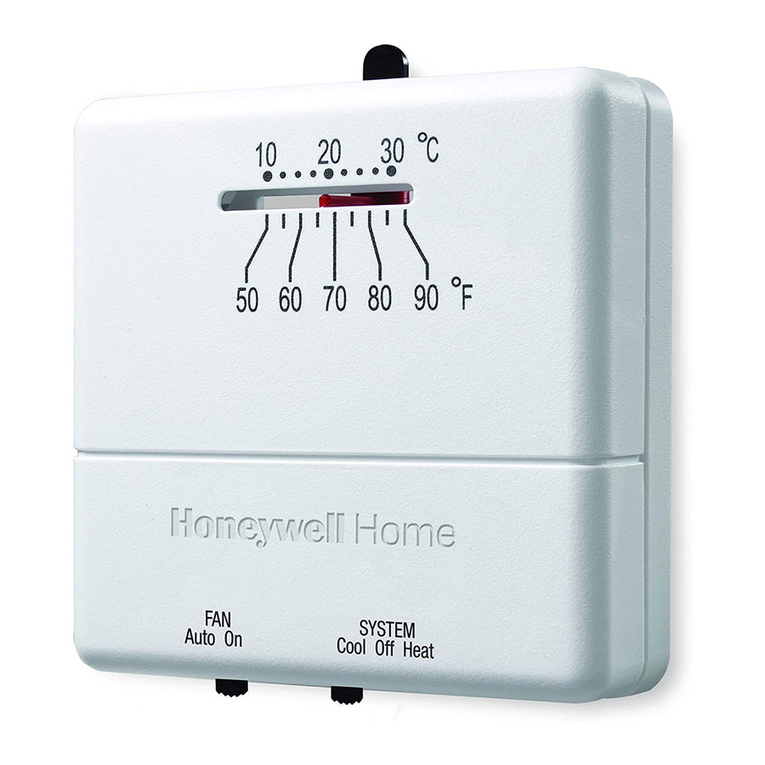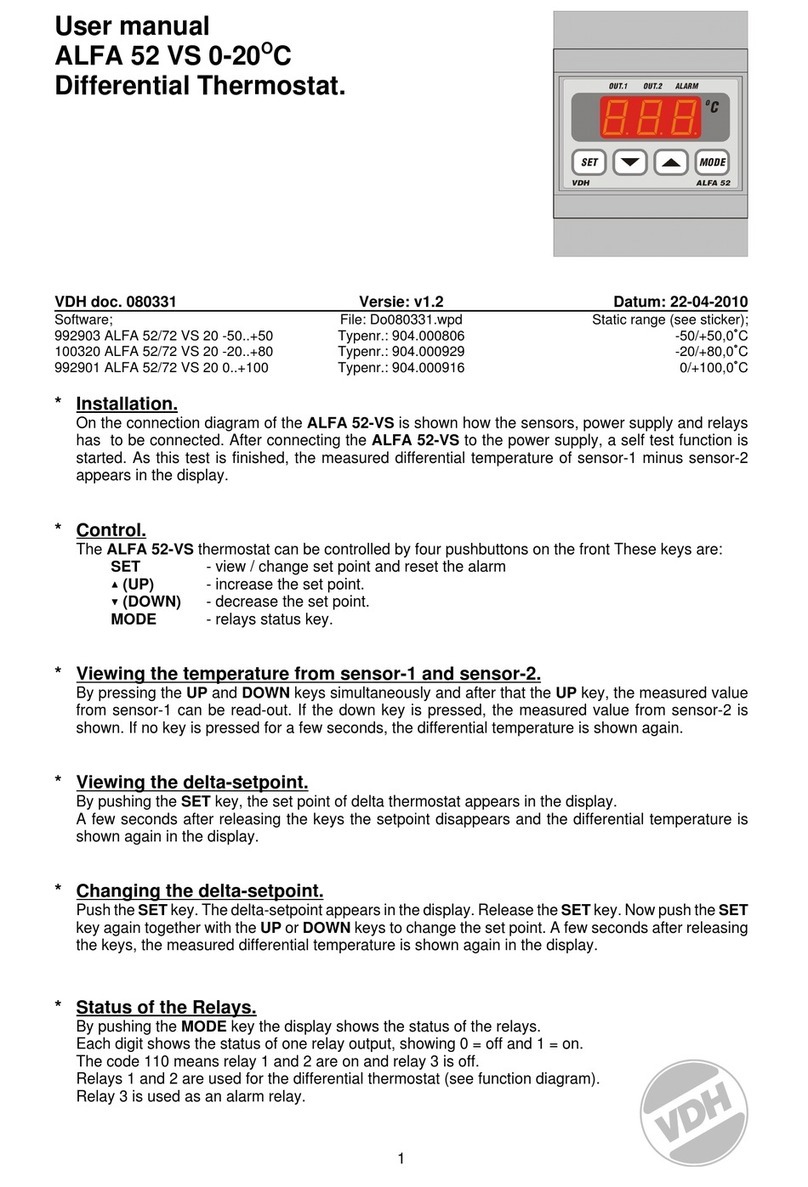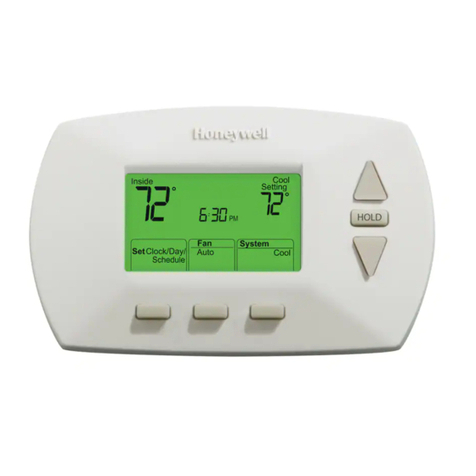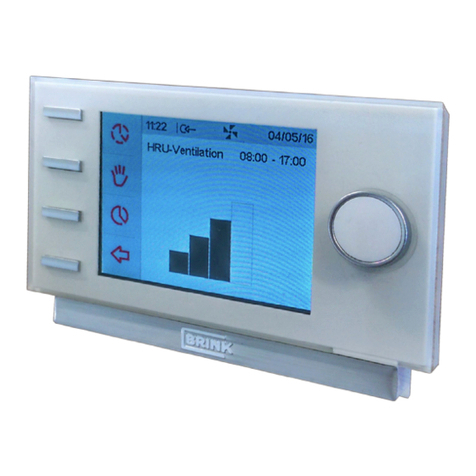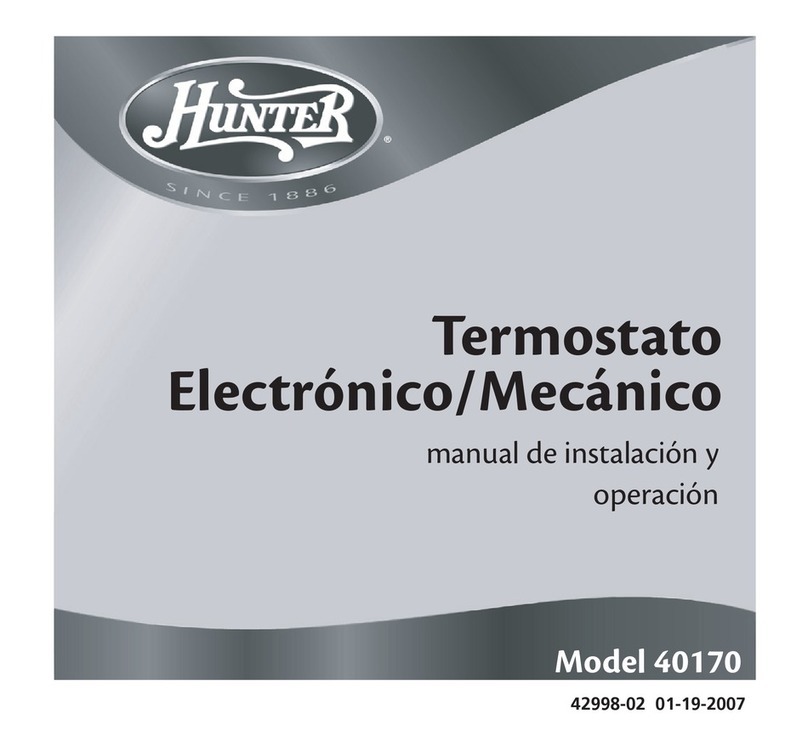Millennial Net MeshScape Wi-Stat IIIp-S User manual

MeshScape®
Energy Management Solution
Wi-Stat IIIp-S
Standalone Programmable Pneumatic
Thermostat
Product Manual
DocumentNumber:2012‐PM‐EM‐6424020V2v003
Revision: 03
Released: April2012

Wi-Stat IIIp-S Wireless Pneumatic Thermostat Product Manual
Page 2 of 36 2012-PM-EM-6424020V2v003 Millennial Net, Inc.
CONTENTS
1.0 DOCUMENT OVERVIEW..........................................................3
2.0 WI-STAT IIIP-S OVERVIEW ......................................................3
2.1 HVAC OPERATION ..................................................................................................................3
2.2 OPERATING PRINCIPLE OF WI-STAT IIIP-S PNEUMATIC THERMOSTAT ...................................................4
2.3 STANDALONE OPERATION .........................................................................................................5
2.3.1 Standalone Wi-Stat IIIp-S Operational Modes.................................................................5
2.3.2 Standalone Wi-Stat IIIp-S Occupancy Programming .......................................................6
2.3.3 Standalone Wi-Stat IIIp-S Occupancy Programming Examples .......................................7
2.4 WIRELESS DDC OPERATION.......................................................................................................8
2.4.1 Wireless DDC Wi-Stat IIIp-S Operational Modes..............................................................8
2.4.2 Fail-Safe Features ...........................................................................................................9
2.5 OPTIONAL MOTION SENSOR FUNCTION......................................................................................11
2.6 WIRELESS DDC WI-STAT IIIP-S CONFIGURATION PARAMETERS .......................................................12
2.7 TECHNICAL WI-STAT IIIP-S SPECIFICATIONS.................................................................................15
3.0 WI-STAT IIIP-S CONFIGURATION...........................................17
3.1 WI-STAT IIIP-S CONFIGURATION STEPS ......................................................................................17
3.2 WI-STAT IIIP-S CONFIGURABLE SETTINGS ...................................................................................17
3.3 WI-STAT IIIP-S CONFIGURATION MODE .....................................................................................18
3.4 CONFIGURATION FROM STANDALONE TO WIRELESS DDC...............................................................19
3.5 PROGRAMMING SCHEDULE ON A STANDALONE WI-STAT IIIP-S .......................................................20
3.6 HVAC MODE SCREEN ............................................................................................................22
3.7 FAN MODE SCREEN................................................................................................................22
3.8 MAINTENANCE –PNEUMATIC SETTINGS .....................................................................................23
4.0 WI-STAT IIIP-S INSTALLATION...............................................26
4.1 LIST OF TOOLS AND HARDWARE NEEDED FOR INSTALLATION...........................................................26
4.2 ELECTROSTATIC SENSITIVE DEVICES (ESD) SAFETY MEASURES .........................................................26
4.3 CLEAN AIR REQUIREMENT .......................................................................................................26
4.4 WI-STAT IIIP-S ORDER OF INSTALLATION....................................................................................27
4.5 WI-STAT IIIP-S INSTALLATION STEPS..........................................................................................28
5.0 WI-STAT IIIP-S OPERATION ...................................................31
5.1 LCD DISPLAY .......................................................................................................................32
5.2 ADJUSTING ROOM TEMPERATURE..............................................................................................33
5.3 USING OVERRIDE MODE BUTTON .....................................................................................34
5.4 USING SHOULDER MODE BUTTON .....................................................................................34

Wi-Stat IIIp-S Wireless Pneumatic Thermostat Product Manual
Page 3 of 36 2012-PM-EM-6424020V2v003 Millennial Net, Inc.
1.0 Document Overview
This document summarizes the operation of the Wi-Stat IIIp-S pneumatic thermostat for HVAC
monitoring and control purposes. It provides details of use cases and the overall solution that will
be delivered to meet the needs of supported HVAC applications.
2.0 Wi-Stat IIIp-S Overview
2.1 HVAC Operation
The Wi-Stat IIIp-S wireless pneumatic thermostat is an intelligent
energy conservation device that provides remote zone
monitoring and control for commercial, industrial, and municipal
HVAC environments. It can work as a stand alone
Weekday/Weekend programmable thermostat or can be
converted to wireless DDC thermostat. As a stand alone
programmable thermostat Wi-Stat IIIp-S can independently
operate on user configurable Weekday/Weekend schedule.
If converted to wireless DDC (see Section 2.3 Standalone
Operation) Wi-Stat IIIp-S enables local temperature controls
within the range set by company-wide energy policy rules, bi-
directionally communicated via a mesh network to and from a
remote monitoring and control application. It is an electronic
pneumatic wireless thermostat for intelligent room temperature control in heating and air
conditioning applications.
Designed to replace existing manual pneumatic thermostats, the Wi-Stat IIIp-S provides Direct
Digital Control features, such as remote wireless setpoint control and occupancy scheduling,
continuous room temperature, branch line pressure and battery status monitoring, all of which
were previously unavailable in pneumatic HVAC systems. The innovative design of Wi-Stat IIIp-S
completely reshapes pneumatic HVAC controls - the controller does not utilize any mechanical
parts. A solid state temperature sensor replaces bi-metallic strip elements for precise room
temperature monitoring and the advanced Piezo electric valve actuator replaces mechanical
valve for improved branch line pressure control. These advanced technologies guarantee longer,
more dependable and maintenance-free operation.
Wi-Stat IIIp-S operation is regulated by a number of operational modes which can be triggered
scheduled times. Each mode is designed to optimize energy use under certain conditions and
has a set of rules that will manage HVAC equipment operation and restrict local thermostat
requests. All Wi-Stat IIIp-S variable configuration, management and mode scheduling is done
remotely using a monitoring and control software application.
There are two types of Operational Modes – Scheduled and Manual. Scheduled Modes are
triggered by occupancy schedules and provide energy savings by aligning HVAC operation to
actual building occupancy. Manual Modes can only be initiated by the user at the Wi-Stat level.
They are used to adjust HVAC operation manually outside of the schedule, but within set energy
policy parameters.
Figure 1. Wi-Stat IIIp-S Wireless
Pneumatic Thermostat

Wi-Stat IIIp-S Wireless Pneumatic Thermostat Product Manual
Page 4 of 36 2012-PM-EM-6424020V2v003 Millennial Net, Inc.
2.2 Operating Principle of Wi-Stat IIIp-S pneumatic thermostat
Wi-Stat IIIp-S has been designed to support any 0 ~ 22 PSI pneumatic HVAC control systems.
Variation in branch line pressure is proportional to deviation of room temperature from Set Point;
the proportional factor is determined by the Gain, which is defined as the change in branch line
pressure in PSI in response to a 1°F change in room temperature.
Figure 2 below shows the linear relationship between branch line pressure and room temperature
at a given Set Point for Direct Acting Thermostat configuration (for Reverse Acting the graph
would be flipped horizontally).
Figure 2. Temperature - Pressure Profile
A direct acting system is shown in Figure 2 where Wi-Stat IIIp-S will increase branch line
pressure in response to an increase in room temperature. When room temperature is within the
Dead Zone (default ±1°F) around the Set Point, branch line pressure is regulated at Set Point
Pressure, and the pneumatic actuator will be at the minimum heat, cool or neutral position. When
room temperature rises above Set Point plus Dead Zone, branch line pressure will increase in
proportion to temperature increase, with proportional factor defined by the Gain value. On the
other hand, if room temperature decreases below Set Point minus Dead Zone, branch line
pressure will decrease in proportion to temperature decrease. The proportional band defines the
temperature range where branch line pressure changes in proportion to temperature change.
Note that Set Point Pressure, Dead Zone, Gain, and Proportional Band can be adjusted using the
menu buttons on Wi-Stat IIIp-S or within the Wi-EMS web application.

Wi-Stat IIIp-S Wireless Pneumatic Thermostat Product Manual
Page 5 of 36 2012-PM-EM-6424020V2v003 Millennial Net, Inc.
2.3 Standalone Operation
This section outlines Wi-Stat IIIp-S operation and programming when configured as a
standalone device.
2.3.1 Standalone Wi-Stat IIIp-S Operational Modes
Scheduled Modes:
The following operational modes are regulated by the Schedule programmed on the device.
oOccupied Mode – Occupancy mode is used when the zone is scheduled to be occupied.
The room temperature during this mode will be adjusted by people in the room by
pressing Up and Down buttons. Wi-Stat IIIp-S allows manual temperature control ±14F
around programmed set point (28F total range). Users will be able to program set point
during programming the device (see instruction below). Range cannot be changed.
For example, if the Set Point value is 70°F, people in the room will be able to change
temperature manually between 56° and 84° F.
oUnoccupied Mode – Energy saving mode for the times when rooms are unoccupied.
Temperature in the zone will controlled by Upper and Lower limits - when the room
temperature is between the upper and lower Unoccupied Mode temperature limits the Wi-
Stat IIIp-S will not call for heat or cool. If the temperature will fall outside the Unoccupied
Mode upper and lower temperature range, the Wi-Stat IIIp-S will control the HVAC
system accordingly to bring the environment back into range. Upper and lower limits are
programmable (see instructions below)
Manual Modes:
The following modes cannot be programmed. They can only be initiated locally by the user
interfacing with the Wi-Stat IIIp-S.
oOverride Mode – manual mode will turn Wi-Stat IIIp-S to occupied mode. Can only be
initiated by the user by pressing the Override button on the Wi-Stat IIIp-S. Override
has limited 2 hour duration time; after it expires, the Wi-Stat IIIp-S returns to its regularly
scheduled mode. The Override Mode overrides the scheduled Occupied or Unoccupied
Mode by allowing the user to control the HVAC system through the local thermostat. If
the room temperature is outside the Override Comfort Zone range, the Wi-Stat IIIp-S will
disable local thermostat controls. Override Mode overrules your Energy Policy, so
always check with your administrator before using it.
oShoulder Mode – Energy Saving transition from occupied to unoccupied modes. It can
be triggered locally at the Wi-Stat IIIp-S level by pressing Shoulder button - . While
in Shoulder mode, Wi-Stat IIIp-S will not call for heat or cool when the room temperature
is ±5F within the set point. It is used to set back the room temperature set point
manually if occupants leave the facility earlier than the scheduled time, essentially
overriding the current schedule until the next scheduled mode change occurs. For
example, if a zone is running a five-day, 8AM to 6PM occupancy schedule, but one day
occupants are leaving at 2PM, they can manually set the zone into shoulder mode at
2PM. The Wi-Stat IIIp-S will remain in Shoulder mode until 6PM and then will follow its
regular schedule.

Wi-Stat IIIp-S Wireless Pneumatic Thermostat Product Manual
Page 6 of 36 2012-PM-EM-6424020V2v003 Millennial Net, Inc.
2.3.2 Standalone Wi-Stat IIIp-S Occupancy Programming
This section outlines how scheduling module operates when Wi-Stat IIIp-S configured as a
standalone device. For schedule step-by-step programming instructions please refer to
the part 3.5 Programming Schedule on a Standalone Wi-Stat IIIp-S
Wi-Stat IIIp-S is equipped with independent time clock and can be programmed with
Weekday/Weekend occupancy schedule. Complete 7 day schedule consists of two autonomous
components:
Weekday Schedule – Monday through Friday
Weekend Schedule – Saturday and Sunday
Each component is split into two parts to be schedule as occupied or unoccupied mode:
Weekday 1
Weekday 2
Weekend 1
Weekend 2
To accommodate for daytime or nighttime shift schedules, each part can be configured to
occupied or unoccupied mode independently.
For each Occupied Mode following features can be configured:
Occupied mode start time
Temperature set point value – people will be able to adjust temperature by ±14F around it.
For each Unoccupied Mode following features can be configured:
Unoccupied mode start time
Upper Temperature limit
Lower Temperature limit (Thermostat will be off while temperature is within these limits)
Start time of each schedule part is automatically an end time of the previous one. (i.e. for 6am –
6pm occupied schedule occupied mode to start at 6am and unoccupied at 6pm). Figures below
illustrate Occupied and Unoccupied schedule setup screens.
Figure 3. Wi-Stat IIIp-S Schedule Setup Screen for Occupied mode
Figure 4. Wi-Stat IIIp-S Schedule Setup Screen for Unoccupied mode
For schedule step-by-step programming instructions please refer to the part 3.5 Programming
Schedule on a Standalone Wi-Stat IIIp-S
Weekda
y
1
Occu
p
ied
07:00
70
Weekda
y
2
Unoccu
p
ied
18:00
85 55
Weekday 1, Weekday 2, Weekend 1 or Weekend 2. Defines which part you are editing
Occupied or Unoccupied. Defines occupancy mode of that part
Time (24h format). Defines start time of that part
Set point Temperature. Defines Occupied mode set point temperature of that part
Weekday 1, Weekday 2, Weekend 1 or Weekend 2. Defines which part you are editing
Occupied or Unoccupied. Defines occupancy mode of that part
Time (24h format). Defines start time of that part
Upper Temperature Limit. Defines Unoccupied mode upper temperature limit for that part
Lower Temperature Limit. Defines Unoccupied mode lower temperature limit for that part

Wi-Stat IIIp-S Wireless Pneumatic Thermostat Product Manual
Page 7 of 36 2012-PM-EM-6424020V2v003 Millennial Net, Inc.
2.3.3 Standalone Wi-Stat IIIp-S Occupancy Programming Examples
Standard Office Hours
Set point - 70F
Occupied from 9am to 5pm Monday to Friday
Saturday and Sunday – unoccupied, upper limit - 85F, lower - 55F.
Program Wi-Stat IIIp-S Schedule Setup Screens:
*Start and end time are irrelevant; both weekend parts are set to the same unoccupied mode.
Night Shift Hours
Set point - 70F
Occupied from 3pm to 6am 7 days a week
Program Wi-Stat IIIp-S Schedule Setup Screens:
Extended Office Hours w/ Weekend Schedule
Set point - 70F
Occupied from 8am to 6pm Monday to Friday
Occupied from 10am to 1pm Saturday and Sunday.
Program Wi-Stat IIIp-S Schedule Setup Screens:
For schedule step-by-step programming instructions please refer to the part 3.5 Programming
Schedule on a Standalone Wi-Stat IIIp-S
Weekda
y
1
Occu
p
ied
09:00
70
Weekda
y
2
Unoccu
p
ied
17:00
85 55
Wee
k
end 1
Unoccu
p
ied
09:00*
85 55
Wee
k
end 2
Unoccu
p
ied
17:00*
85 55
Weekda
y
1
Unoccu
p
ied
06:00
85 55
Weekda
y
2
Occu
p
ied
15:00
70
Wee
k
end 1
Unoccu
p
ied
06:00
85 55
Wee
k
end 2
Occu
p
ied
15:00
70
Weekda
y
1
Occu
p
ied
08:00
70
Weekda
y
2
Unoccu
p
ied
18:00
85 55
Wee
k
end 1
Occu
p
ied
10:00
70
Wee
k
end 2
Unoccu
p
ied
13:00
85 55

Wi-Stat IIIp-S Wireless Pneumatic Thermostat Product Manual
Page 8 of 36 2012-PM-EM-6424020V2v003 Millennial Net, Inc.
2.4 Wireless DDC Operation
This section is only applicable if Wi-Stat IIIp-S is being used as wireless DDC device.
Configured as a standalone programmable device it will not communicate data wirelessly.
Wi-Stat IIIp-S can operate as a wireless thermostat designed to monitor and control pneumatic
HVAC systems as part of the overall Millennial Net Wireless Energy Management Solution. Wi-
Stat IIIp-S is equipped with 2.4GHz IEEE 802.15.4 radio and can communicate via MeshScape®
mesh network protocol. The wireless mesh network forms itself and data communications enable
remote monitoring, adjustment and trending to ensure long term performance. It communicates
data over the wireless network in conjunction with other wireless Millennial Net devices. In the
wireless mesh network Wi-Stat IIIp-S operates as a battery-powered end node. When installed in
buildings with common sheetrock walls, its nominal radio communication range is approximately
200 feet. However, if the Wi-Stat IIIp-S is located more than 200 feet from the Wi-Site network
controller, Wi-Routers must be deployed to relay data generated by the Wi-Stat IIIp-S back to the
network controller. Being an end node, Wi-Stat IIIp-S does not support routing function to relay
data for other devices in the mesh network. It communicates with the wireless mesh network as
an individual device that transmits and receives its own data only, to and from the Wi-Site
network controller or through other routing devices,
The first step of the installation process is planning the layout of devices on the building’s floor
plan, including the identification of desired locations for all Wi-Stat IIIp-S devices as well as the
Wi-Site network controller. Measure the radial distances between the Wi-Stat IIIp-S devices and
the Wi-Site network controller to determine if the Wi-Stat IIIp-S devices are within 200 feet of the
Wi-Site. If not, Wi-Routers must be installed to relay signals between the Wi-Stat IIIp-S and the
Wi-Site. The ideal installation provides each end node device, Wi-Stat IIIp-S, with at least two
routes of transmission to the Wi-Site to ensure signal transmission success. Nominal
transmission range of Wi-Routers in common buildings is 300 feet. To ensure complete coverage
of a wireless mesh network, there should be at least two Wi-Routers or one Wi-Router and the
Wi-Site located within a 300 foot radius of every Wi-Stat IIIp-S.
2.4.1 Wireless DDC Wi-Stat IIIp-S Operational Modes
Scheduled Modes:
The following operational modes are regulated by the HVAC Schedule as defined by the user.
Schedules can be set well in advance through a monitoring and control software application and
Wi-Stat IIIp-S will execute them automatically.
oOccupied Mode – Occupancy mode is used when the zone, or room, is scheduled to be
occupied. The room temperature during this mode is defined by two values: Set Point
(the targeted room temperature for the season) and Comfort Zone (the optimal
temperature range around the Set Point). Both values are set by the Energy Policy and
the Wi-Stat IIIp-S will maintain the room temperature within the Comfort Zone. If the
temperature in the room falls outside of the Comfort Zone range, Wi-Stat IIIp-S will react
accordingly and will automatically request to heat or cool. To enhance user compliance
with the Energy Policy, Wi-Stat IIIp-S will allow users to adjust the room temperature
using the local thermostat, as long as the desired temperature is within the range of the
Comfort Zone. If the user requests heat or cool outside of the set Comfort Zone, the
request at the local thermostat will be overwritten by the Energy Policy. For example, the
Set Point value is 70° F and the Comfort Zone Delta is 3° F. The user will only be able to
affect the temperature manually between 67° and 73° F.
oUnoccupied Mode – Energy saving mode for the times when rooms are unoccupied.
When the room temperature is between the upper and lower Unoccupied Mode
temperature limits the Wi-Stat IIIp-S will not call for heat or cool. If the temperature falls
outside the Unoccupied Mode upper and lower temperature range, the Wi-Stat IIIp-S will
control the HVAC system accordingly to bring the environment back into range.

Wi-Stat IIIp-S Wireless Pneumatic Thermostat Product Manual
Page 9 of 36 2012-PM-EM-6424020V2v003 Millennial Net, Inc.
Manual Modes:
The following modes cannot be scheduled or triggered remotely. They can only be initiated
locally by the user interfacing with the Wi-Stat IIIp-S.
oOverride Mode – manual mode – can only be initiated by the user by pressing the
Override button on the Wi-Stat IIIp-S. Override has a limited duration time, set by
the Energy Policy; after it expires, the Wi-Stat IIIp-S returns to its regularly scheduled
mode. The Override Mode overrides the scheduled Occupied or Unoccupied Mode by
allowing the user to control the HVAC system through the local thermostat and permits a
wider Comfort Zone range. If the room temperature is outside the Override Comfort Zone
range, the Wi-Stat IIIp-S will disable local thermostat controls. The Override Mode
Comfort Zone range and Override duration time are set by the Energy policy. Override
Mode overrules your Energy Policy, so always check with your administrator
before using it.
oShoulder Mode – Energy Saving transition from occupied to unoccupied modes. It can
be triggered locally at the Wi-Stat IIIp-S level by pressing Shoulder button - . While
in Shoulder mode, Wi-Stat IIIp-S will not call for heat or cool when the room temperature
is between Upper and Lower Shoulder mode temperature limits. It is used to set back
the room temperature set point manually if occupants leave the facility earlier than the
scheduled time, essentially overriding the current schedule until the next scheduled mode
change occurs. For example, if a zone is running a five-day, 8AM to 6PM occupancy
schedule, but one day occupants are leaving at 2PM, they can manually set the zone into
shoulder mode at 2PM. The Wi-Stat IIIp-S will remain in Shoulder mode until 6PM and
then will follow its regular schedule. Shoulder mode can also be utilized as a Demand
Response mode and can be triggered remotely from the monitoring and control
application.
All parameter-defining rules of each mode are configurable. Please see the “Wi-Stat IIIp-S
Configuration Parameters” table below, in section 2.6.
2.4.2 Fail-Safe Features
Wi-Stat IIIp-S has a number of programmed fail-safe features to ensure continuous HVAC
operation. In the event of communication failure with servers, wireless network, or HVAC
equipment:: a fail-safe mechanism will ensure devices continue to operate in a logical fashion
without diverging into extensive failure. When failure condition no longer exists, the device will
recover from safe mode and resume normal operation.
•Server communication failure – Site Controller (communicant device between Wi-
Stat IIIp-Ss and the server) cannot receive latest commands or send data to the
server
In instances when the Wi-Site fails to communicate with the server, the Wi-Site will
continue to use the 7-day schedule stored in its memory (assuming a schedule is used)
and all Wi-Stat IIIp-Ss will continue controlling HVAC equipment accordingly. During
server communication failure, Wi-Site will continue to log data from the wireless network
until its flash memory is full. Data will no longer be logged once the memory is full
however; when communication is restored, Wi-Site will be able to send all archived data
to the server and receive the updated schedule from the server.
•Wi-Stat IIIp-S loses radio communication with Site Controller
Should the Wi-Stat IIIp-Ss experience radio communication failure with the Wi-Site, Wi-
Stat IIIp-Ss will follow default single day schedules, preset on the Wi-Stat IIIp-S. Wi-Stat
IIIp-S has a built in real time clock (RTC) which is synchronized with the wireless mesh
network, therefore, it can operate with a default, hard-coded day schedule even when it is

Wi-Stat IIIp-S Wireless Pneumatic Thermostat Product Manual
Page 10 of 36 2012-PM-EM-6424020V2v003 Millennial Net, Inc.
offline. When Wi-Site comes back online, the Wi-Stat IIIp-Ss will automatically receive
updated mode status, Set Point values and other configuration commands based on the
latest user schedule.
•Protection Zone
To protect building infrastructure, equipment, and occupants, Wi-Stat IIIp-S has extreme
temperature limits (configurable by Administrator) that will allow temperatures to float
independently from any mode settings. If these limits are reached, Wi-Stat IIIp-S will
automatically react and adjust Heat or Cool, no matter what scheduled mode is running.
Default value for Upper bound is 95° F, and the Lower bound default value is 40° F.

Wi-Stat IIIp-S Wireless Pneumatic Thermostat Product Manual
Page 11 of 36 2012-PM-EM-6424020V2v003 Millennial Net, Inc.
2.5 Optional Motion Sensor Function
The Wi-Stat IIIp-S supports motion sensor function where Wi-StatIIIp-S will automatically go into
Shoulder Mode (refer to Section 2.3.1 Standalone Wi-Stat IIIp-S Operational Modes) to save
energy when no motion is detected for a configurable period of time. Motion sensors with dry
contact signals can be connected to the motion sensor screw terminals of the Wi-Stat IIIp-S.
Upon detecting motion, the motion sensor should “make” the connection for longer than 30
seconds for Wi-Stat IIIp-S to confirm valid motion detection. The default value of motion detection
grace period is 30 minutes, and can be changed through Modbus or BACnet interface, with
minimum 30 minutes and maximum 100 minutes. Please refer to Wi-Stat IIIp-S BACnet object list
for details. If no motion is detected for more than the grace period, and it is in schedule occupied
mode, Wi-Stat3p will go into shoulder mode. Wi-Stat IIIp-S goes into shoulder mode only during
schedule occupied periods. Shoulder mode will not be activated while the device is in unoccupied
periods.
There are several means for Wi-Stat IIIp-S to exit shoulder mode:
Motion detection – Wi-Stat IIIp-S goes back to occupied mode if motion is detected and the
device schedule is in occupied mode.
Shoulder mode button press – while in shoulder mode, if the shoulder mode button is
pressed.
Override mode button press – while in shoulder mode, if the override mode button (button
with a sun icon) is pressed.
Schedule change – if schedule changes from occupied to unoccupied then Wi-Stat IIIp-S will
go into unoccupied mode.
To disable the motion sensor function, a jumper wire must be connected to the motion sensor
screw terminals, which effectively simulates motion detection and therefore Wi-Stat3p will not go
into shoulder mode due to lack of motion.
Figure 4. Wi-Stat IIIp-S Firmware Version Screen
Motion Sensor
Connection / Jumper

Wi-Stat IIIp-S Wireless Pneumatic Thermostat Product Manual
Page 12 of 36 2012-PM-EM-6424020V2v003 Millennial Net, Inc.
2.6 Wireless DDC Wi-Stat IIIp-S Configuration Parameters
The following variables define rules of your Energy policy and regulate Wi-Stat IIIp-S operation.
Table 1. Configuration Parameters
Parameters Description Configurati
on Method
Occupied Mode
Set Point value Zone Set Point temperature Software
Comfort Zone upper
delta (3° F default) Upper temperature bound on deviation from energy
policy Set Point during occupied mode. Software
Comfort Zone lower
delta (3° F default) Lower temperature bound on deviation from energy
policy Set Point during occupied mode. Software
Unoccupied Mode
Constrained float
upper limit (85° F
default)
Defines upper temperature limit in unoccupied
mode.
HVAC equipment will remain off while the zone
temperature is between upper and lower limits.
Software
Constrained float lower
limit (55° F default)
Defines lower temperature limit in unoccupied mode.
HVAC equipment will remain off while the zone
temperature is between upper and lower limits. Software
Override mode
Override duration
(default 120 minutes)
Wi-Stat override duration. After time limit expires,
Wi-Stat IIIp-S will go into regularly scheduled mode.
Maximum 240 minutes Software
Override mode
Comfort Zone upper
delta (5° F default) Comfort Zone upper delta during override mode. Software
Override mode
Comfort Zone lower
delta (5° F default) Comfort Zone lower delta during override mode. Software
Other Parameters
HVAC mode (Auto
default)
Auto: Wi-Stat IIIp-S will call for heat or cool.
Heat: Wi-Stat IIIp-S will only call for heat (for heat
only systems)
Cool: Wi-Stat IIIp-S will only call for cool (for cool
only systems)
Software,
Wi-Stat IIIp-S
HVAC transition delta
(5° F default)
Temperature delta before Wi-Stat IIIp-S will
automatically transition from heat to cool or from
cool to heat based on zone temperature Software
Operational Modes 1: Occupied; 2: Unoccupied Wi-EMS
Scheduler
Dead zone delta (1° F
default) Temperature range around Set Point to prevent
HVAC from chattering Software
Wi-Stat protection
zone upper
temperature (95° F
default)
Maximum temperature allowed in zone. Fail-safe
feature, applicable to all zones. Modification
on request
Wi-Stat protection
zone lower
temperature (40° F
Minimum temperature allowed in zone. Fail-safe
feature, applicable to all zones. Modification
on request

Wi-Stat IIIp-S Wireless Pneumatic Thermostat Product Manual
Page 13 of 36 2012-PM-EM-6424020V2v003 Millennial Net, Inc.
default)
Heat cycle timer Minimal heat-on to heat-on interval; value range 0 ~
30 minutes, increment in minutes; default 0 minute Modification
on request
Compressor restart
delay Minimal cool-off to cool-on interval; value range 0 ~
30 minutes, increment in minute; default 0 minute Software
Default occupied mode
start time in case of
wireless
communication failure
(06:00am default)
Time of day in hour (0 ~ 24); used in the event the
Wi-Stat IIIp-S goes offline for extended durations Modification
on request
Default occupied Set
Point value in case of
wireless
communication failure
(70° F default)
Used in the event the Wi-Stat IIIp-S goes offline for
extended durations Modification
on request
Default unoccupied
Set Point start time in
case of wireless
communication failure
Time of day in hour (0 ~ 24); used in event the Wi-
Stat IIIp-S goes offline for extended durations;
disabled in default configuration, and therefore unit
does not go into unoccupied mode when offline.
Modification
on request
Temp sensor
calibration factor (° F) To calibrate Wi-Stat IIIp-S temperature sensor for
offset compensation Modification
on request
Wall time interval for
synchronized data
reporting (default not
reporting on
synchronized wall
time)
Data reporting interval when device reports on
synchronized wall time, in minutes of the hour;
allowable values: 1 (5 minutes), 2 (6 minutes), 3 (10
minutes), 4 (12 minutes) , 5 (15 minutes), 6 (20
minutes) , 7 (30 minutes), and 8 (1 minute)
Modification
on request
Shoulder mode
Comfort Zone upper
delta Defines upper temperature limit in shoulder mode Modification
on request
Shoulder mode
Comfort Zone lower
delta Defines lower temperature limit in shoulder mode Modification
on request
Direction
Direct Acting - branch line pressure increase turns
on Cooling, decrease turns on Heating
Reverse Acting - branch line pressure increase turns
on Heating, decrease turns on Cooling.
Software,
Wi-Stat IIIp-S
Set Point PSI Branch line pressure when the room temperature
and Set Point are equal; no Heating or Cooling
outputs.
Software,
Wi-Stat IIIp-S
Gain /Sensitivity Number of degrees impacted by 1 PSI change Software,
Wi-Stat IIIp-S
Prop band -
Proportional
range/throttling range
Temperature range that represents the controlled
device’s movement from fully closed to fully open.
Typically it is 4°F or 6°F
Software,
Wi-Stat IIIp-S
Unoccupied Mode PSI Branch line pressure during unoccupied mode when
zone temperature is within unoccupied constrained
upper and lower limits.
Software,
Wi-Stat IIIp-S

Wi-Stat IIIp-S Wireless Pneumatic Thermostat Product Manual
Page 14 of 36 2012-PM-EM-6424020V2v003 Millennial Net, Inc.

Wi-Stat IIIp-S Wireless Pneumatic Thermostat Product Manual
Page 15 of 36 2012-PM-EM-6424020V2v003 Millennial Net, Inc.
2.7 Technical Wi-Stat IIIp-S Specifications
Parameter Value Unit Notes
Pneumatic Features
Thermostat Type 2 - Pipe, Multiple Temperature Setpoints, Summer / Winter thermostat
Contact Action Direct / Reverse Acting, Dead Band Control
Element Type Piezo electric valve actuator
Air Connections ¼” or (6.35 mm)
5/32” (4.00 mm)
Airflow Usage 0.011 scfm (5.2 mL/s)
Throttling Range 0 – 10 F User configurable
Pressure Measurement
Sensor type Surface mount pre-amplified pressure gauge
Measurement range 0 ~ 30 PSI
Accuracy 1.5% full scale %
Pneumatic Output Ports
Main line Port M port Maximum main line pressure 30 psi
Branch line Part Br port Actively controlled with pressure sensor
feedback for various pressure level
requirements
Temperature Measurement
Sensor type Integrated circuit sensor Low current drain, < 90 uA
Measurement range -50°F ~ +300°F
(-10°C ~ +149°C) °F (°C)
Accuracy ±1.00 (±0.56) °F (°C)
Power
Internal batteries 3.6 VDC Four AA lithium batteries
External DC supply 6 maximum VDC Through screw terminal
Minimum supply voltage 3.6 VDC
Estimated battery life Up to 5 Years With minimum pneumatic line leakage, w/ 4
Lithium Batteries
Parameter Value Unit
Display
Display type Liquid crystal
Displays temperature, branch line pressure, Set Point,
occupied / set back mode, heat / cool / fan status, battery
voltage & wireless connection status; supports Set Point
adjustment, HVAC mode (auto / heat only / cool only) selection,

Wi-Stat IIIp-S Wireless Pneumatic Thermostat Product Manual
Page 16 of 36 2012-PM-EM-6424020V2v003 Millennial Net, Inc.
fan mode selection (auto / on), and maintenance mode
selection
Radio
Operating frequency range 2405 ~ 2475 MHz ISM band
Number of available channels 15 IEEE 802.15.4 channels 11 ~ 25
Channel spacing 5 MHz
Maximum RF transmit power 18 dBm
Receiver sensitivity -95 dBm At 10 -5 bit error rate
RF data transmission rate 250 Kbits/sec
Channel agility Yes Automatically realigns RF channel when
network (MeshGate) switches to a new channel.
Environmental & Mechanical
Operating temperature range 14°F to 131°F
(-10°C to 55°C) °F (°C)
Storage temperature range -40°F to 185°F
(-40°C to 85°C) °F (°C)
Dimension 108x102x36
(4.3x4.0x1.4) mm (in)
Weight 8.1 oz
Regulatory Compliance
FCC and IC for unlicensed operation

Wi-Stat IIIp-S Wireless Pneumatic Thermostat Product Manual
Page 17 of 36 2012-PM-EM-6424020V2v003 Millennial Net, Inc.
3.0 Wi-Stat IIIp-S Configuration
Wi-Stat IIIp-S configuration can be done at the device before installation or through software
(wireless DDC only) when installation is complete. The following steps describe pre-installation
device level configuration.
3.1 Wi-Stat IIIp-S Configuration Steps
Configuration is only needed is equipment was shipped without customizing pneumatic
configurations. Skip this step if you already supplied Millennial Net or their reseller with
configurations such as Acting direction, Set point and Set back branch line PSI, Throttling range,
Gain and HVAC mode. it is always a good practice to check configurations by following the steps
outlined below.
Wi-Stat IIIp-S thermostat is compatible with wide array of pneumatic HVAC systems. Once
installed, it will begin controlling HVAC equipment based on the settings it was configured to. To
ensure proper operation, its pneumatic and particular operational settings must be configured to
work with your HVAC system. Because Wi-Stat IIIp-S is a battery-powered device with internal
memory, configuration can be done prior to or right after installation. To prevent any possible
operation conflicts, we recommend you configure all Wi-Stat IIIp-S thermostats before the
installation.
3.2 Wi-Stat IIIp-S Configurable Settings
Below is the list of configuration variables that define how Wi-Stat IIIp-S pneumatic pressure
commands will correlate with the temperature values. Refer to your HVAC equipment
documentation or service personnel for the actual values that should be configured on Wi-Stat
IIIp-S.
Settings Details Range Increments
System
Defaults
Operational
HVAC Mode
Heat Only – for Heat only systems
Cool Only – for Cool only systems
Auto – for both Heat and Cool systems N/A N/A Auto
Fan Mode
Only applicable if Fan Relay is used.
See Figure 8.
Auto – to run Fan only with Heating or
Cooling
On – to run Fan continuously during
occupied mode
Speed X – not supported in this version
N/A N/A Auto
Pneumatic
Direct Acting - branch line pressure
increase turns on Cooling, decrease
turns on Heating
Direction
Reverse Acting - branch line pressure
increase turns on Heating, decrease
turns on Cooling.
N/A N/A
Direct
Acting
Set Point PSI Branch line pressure when the room
temperature and Set Point are equal.
Heating and Cooling outputs are OFF. 1 - 22 PSI 0.5 PSI 9 PSI
Gain /Sensitivity Branch line pressure change needed to
change room temperature by 1° F. 1 - 5 PSI 0.5 PSI 2 PSI
Prop band - Temperature range that represents the 0 - 10° F 1° F 6° F

Wi-Stat IIIp-S Wireless Pneumatic Thermostat Product Manual
Page 18 of 36 2012-PM-EM-6424020V2v003 Millennial Net, Inc.
Proportional
range/throttling
range
controlled device’s movement from fully
closed to fully open. Typically it is 6° F or
4PSI
Unoccupied
Mode PSI Branch line pressure during unoccupied
mode. Heat/Cool outputs are OFF. 0 – 22 PSI 0.5 PSI 0 PSI
3.3 Wi-Stat IIIp-S Configuration Mode
1. Separate the wall plate from the Wi-Stat IIIp-S thermostat.
2. Install four Lithium 3.6V batteries (supplied) into battery compartment. Be sure to match
positive (+) battery ends with positive (+) battery terminals in the battery compartment.
(See Figure 9 below)
3.Once powered, if configured as wireless DDC Wi-Stat IIIp-S will initialize in:
a. 30 sec if it can connect to the network
b. 3 minutes if network is not present
Do not press any buttons during initialization process! Configuration changes made
during initialization will not be saved!
See Figure 10 for LCD screen during initialization.
4. Press and hold Shoulder and Override buttons at the same time for 10 seconds
to set Wi-Stat IIIp-S into Configure Mode. LCD screen will change to Firmware Info Menu
(See Figure 5. below) first and in 10 seconds Configuration Menu will appear (See Figure
6. below)
5. Use Up (+) and Down (-) buttons to navigate through the Menu – see directions below
6. If the Configuration Screen is left idle for 10 seconds, it will return to the normal operation
screen
7. All further configurations must be made while in Configuration Mode.
Figure 5. Wi-Stat IIIp-S Firmware Version Screen
DF: Dis
p
la
y
Firmware Number
RF: Radio Module Firmware Number
CH: Radio Channel Number
GI: Device Network Grou
p
ID
DI: Uni
q
ue Thermostat Device ID

Wi-Stat IIIp-S Wireless Pneumatic Thermostat Product Manual
Page 19 of 36 2012-PM-EM-6424020V2v003 Millennial Net, Inc.
Standalone Wireless DDC
Figure 6. Wi-Stat IIIp-S Configuration Menu and Buttons
3.4 Configuration from Standalone to Wireless DDC
1. Press and hold Shoulder and Override buttons at the same time for 10 seconds
to set Wi-Stat IIIp-S into Configure Mode. LCD screen will change to Firmware Info Menu
(See Figure 5. above) first and in 10 seconds Configuration Menu will appear (See Figure
6. above). First line in Configuration Menu will indicate current configuration:
a. “Standalone” – Standalone configuration
b. “Mesh” - Wireless DDC configuration
2. When in Configuration menu, press button, it will highlight first line. Use Up (+) and
Down (-) buttons to change value
3. Press button again to save new configuration.
4. Press button to exit the menu.
Changing from Standalone to Wireless DDC
Wi-Stat IIIp-S will initialize in:
a. 30 sec if it can connect to the network
b. 3 minutes if network is not present
Do not press any buttons during initialization process! Configuration changes made
during initialization will not be saved!
See Figure 10 for LCD screen during initialization.
Changing from Wireless DDC to Standalone:
Set the time right away, error code 1024 will be displayed until the time is configured (see Part
4.1 LCD Display for more information on error codes. Directions how to set the time and
occupancy program are below. Every time you change configuration from Standalone to Mesh
and back, previous time settings will be lost. Please reconfigure time every time you switch to
Standalone.
Press Shoulder and Override Buttons at
the same time for 10 seconds to bring up
the Configuration Menu
Up Button - To scroll up
menu selection
Down Button - To scroll
down menu selection
Go Back to Previous
Confirm Item Button

Wi-Stat IIIp-S Wireless Pneumatic Thermostat Product Manual
Page 20 of 36 2012-PM-EM-6424020V2v003 Millennial Net, Inc.
3.5 Programming Schedule on a Standalone Wi-Stat IIIp-S
To configure Standalone Wi-Stat IIIp-S schedule follow the directions below:
1. Set time
2. Program Weekday/Weekend Occupancy and temperature set points
Configuration Menu
1. Press and hold Shoulder and Override
buttons at the same time for 10 seconds to set Wi-Stat
IIIp-S into Configure Mode. LCD screen will change to
Firmware Info Menu (See Figure 5. above) first and in
10 seconds Configuration Menu will appear (See
Figure 6. above). Confirm the first line in Configuration
Menu shows “Standalone”. If it indicates “Mesh”,
follow directions above to switch to Standalone mode.
2. Use Up (+) and Down (-) buttons to underline lower
Standalone menu item
3. Press Confirm button to enter Standalone
Configuration Menu
Time Clock Setup
4. With Date & Time item underlined, press button
to enter setup screen
5. In the Date & Time menu highlight each line you need
to edit by pressing button.
6. Use Up (+) and Down (-) buttons to change value
7. Press button to save
8. Repeat until Year, Month, Day, Hour and Time is
configured correctly
9. Use Up (+) and Down (-) buttons to scroll between
lines
Standalone
HVAC Mode
Fan Mode
Standalone
Maintenance
Standalone
HVAC Mode
Fan Mode
Standalone
Maintenance
Standalone
Date & Time
Weekday
Weekend
Year 2012
Month 01
Da
y
01
Hour 01
Minute 01
Table of contents
Popular Thermostat manuals by other brands

Honeywell
Honeywell FocusPRO TH5000 Series operating manual
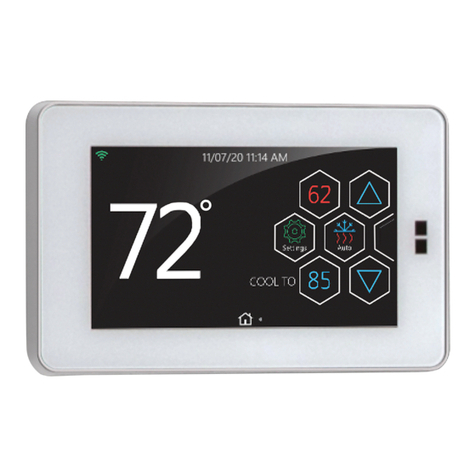
Johnson Controls
Johnson Controls Hx3 S1-THXU430W User's information manual

Honeywell
Honeywell T8090A/191108A owner's manual
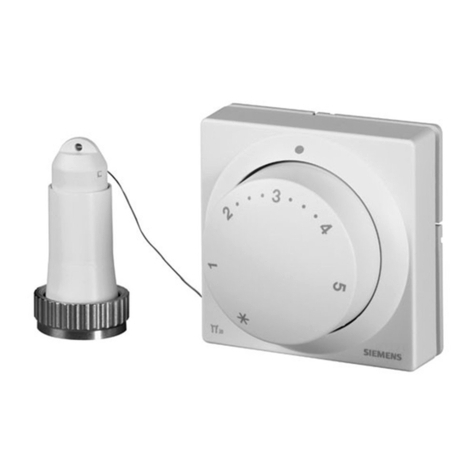
Siemens
Siemens Acvatix RTN81 Mounting instructions

Honeywell
Honeywell THP2400A1019 installation guide
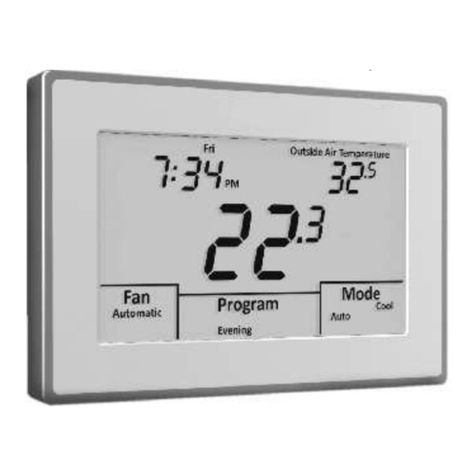
Smart temp
Smart temp Apollo 44-800 user manual
